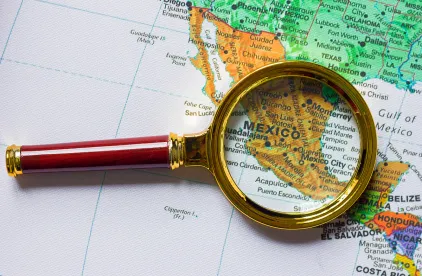The COVID-19 Omicron variant is causing an increase in the rate of infection throughout Mexico (as elsewhere globally), resulting in the federal government’s decision to direct three of Mexico’s thirty-two states to take strong measures to control the spread of the pandemic, such as limiting business affairs to only essential activities and significantly reducing on-site worker capacity.
The worsening pandemic has also prompted the Mexican Social Security Institute (IMSS) to relaunch a program that provides individuals who have contracted COVID-19 with a “COVID-19 Permit,” which beneficiaries can use to take leave from work and receive a sick-leave subsidy from the IMSS. Individuals who have contracted the virus and who are symptomatic are entitled to take seven days of subsidized leave. Individuals who have received a positive test result but are not displaying symptoms are entitled to five subsidized days of leave. Individuals whose leave is approved by the IMSS must notify their employers to justify their absences from work.
Baja California Sur, Chihuahua, and Tamaulipas are the three states currently operating under orange status restrictions, according to the federal government’s traffic light pandemic monitoring system. States in orange status limit the number of workers allowed on-site, among other restrictions. Another ten states, up from only three in the previous edition of this report, are in yellow status, at which point all work activities are allowed, but with measures taken to reduce the risk of infection among people at high risk of developing severe COVID-19–related symptoms.
The biweekly four-tiered monitoring system was implemented in June 2020 and is used to alert residents to the epidemiological risks of COVID-19 and provide guidance on restrictions on certain activities in each of the country’s states. Below is a map for the period of January 10–23, 2022, indicating the COVID-19 risk level in each of the states and the capital.

This chart presents the traffic light status of each state, and, as applicable, variations between federal and local traffic light statuses based on publications of the federal Ministry of Health and status reports provided by each state. Some states may impose lesser or greater restrictions than those imposed by the federal government. For example, Baja California, which the federal government designated in yellow status, has imposed orange-status restrictions. And Tamaulipas has decided to impose red-status restrictions in many of its municipalities, meaning that only essential activities are allowed.
Vaccinations and Pandemic Key Indicators
Ninety-one percent of the nearly 82.7 million people who have been vaccinated to date have been fully vaccinated, the federal Ministry of Health stated in its January 12, 2022, Daily Technical Report. The daily report also pointed out that a little more than 201.3 million vaccine doses had been made available so far.
According to the Ministry of Health’s pandemic tracking data, since the beginning of the pandemic, there have been more than 4.2 million confirmed COVID-19 cases. The data also shows that as of January 13, 2022, 300,912 people had died of COVID-19–related complications. (The number of COVID-19–related deaths could be higher, according to federal data on “excess mortality.”)
Mexico City
Mexico City’s pandemic tracking data reveals that as of January 12, 2022, more than 52,000 COVID-19 cases had been confirmed since New Year’s Day. However, the Mexico City Monitoring Committee has not updated its October 2021 decree designating the capital in green status. Therefore, since early November 2021, business and social affairs in Mexico City have generally been approved to take place without restriction.
The committee also has not updated the guidelines for private corporate offices, so employers may want to continue to limit the percentage of employees working on-site to 80 percent, in accordance with Mexico City’s industry-specific health protection guidelines. Employers in corporate office settings may also want to follow guidance stipulating that employers provide at their own expense and on a weekly basis rapid antigen tests or reverse transcription polymerase chain reaction (RT-PCR) tests for the detection of the SARS-CoV-2 virus, to at least 20 percent of the personnel attending work on-site.
Finally, the verification visits by the Administrative Verification Institute along with other Mexico City government authorities will continue to verify compliance with general and specific sanitary measures for health protection in workplaces. Employers found to be out of compliance with the measures may be fined or be subject to total or partial temporary suspensions of work centers for up to 15 calendar days. Noncompliant employers may also be subject to other applicable sanctions.





 />i
/>i

